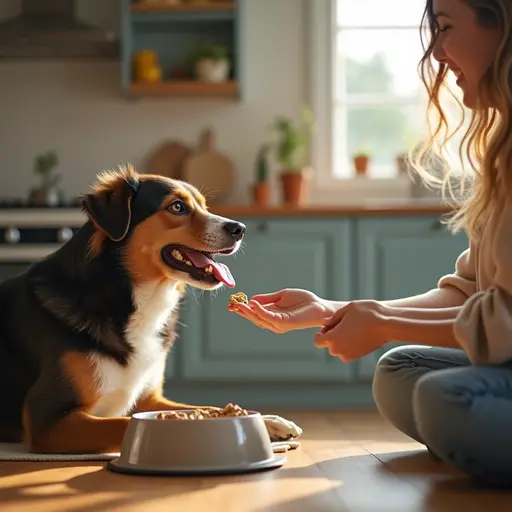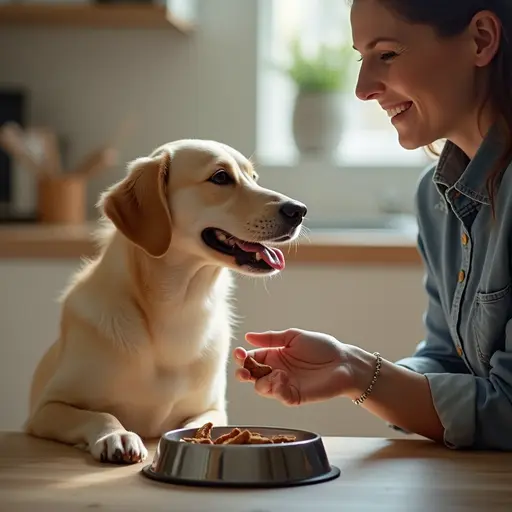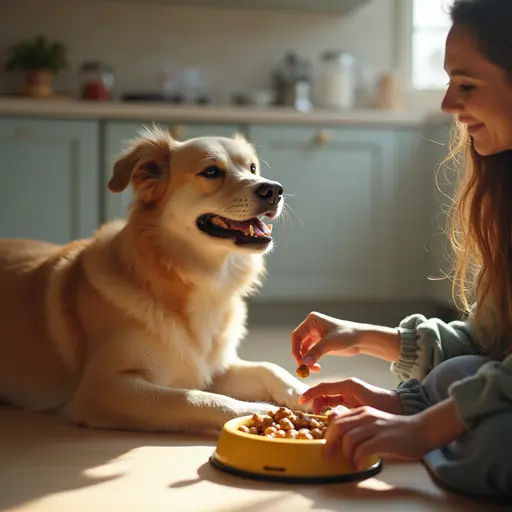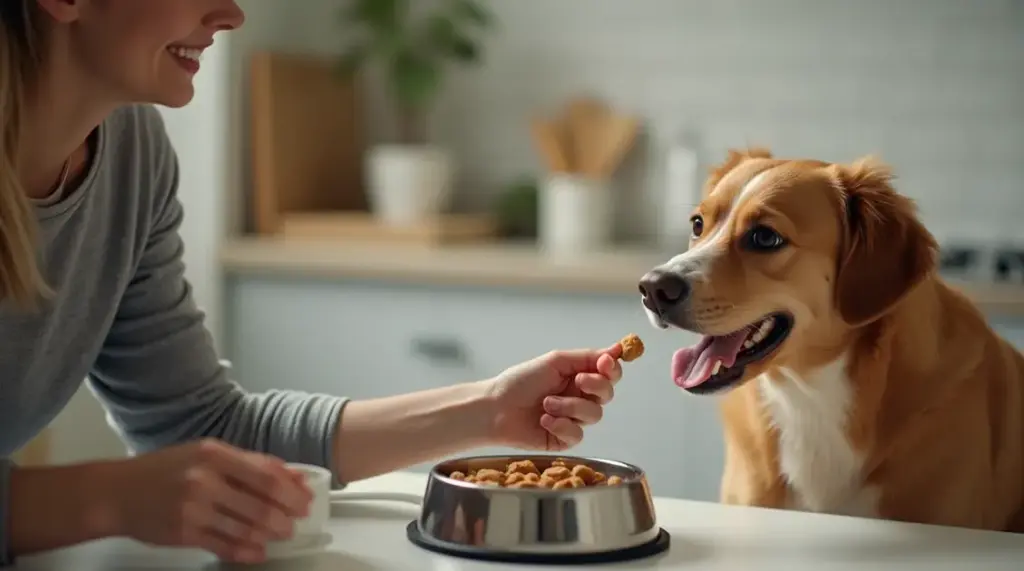Understanding Food Aggression in Dogs
Picture a dog stiffening over its bowl, lips curled in a low growl as someone approaches. This isn’t just “bad manners”—it’s food aggression, a behavior rooted in a dog’s instinct to protect resources.
Also called resource guarding, it ranges from subtle signs (like hovering over a bowl) to overt aggression (snapping or biting). While exact numbers vary, studies suggest up to 20% of dogs exhibit some form of this behavior, though many cases go unreported.
Owners often dismiss early warnings, assuming their pet is merely “possessive,” not recognizing the stress driving the behavior. It’s especially common in rescue dogs or those from environments where food is scarce, but even well-loved family pets can develop these tendencies.
Causes and Triggers
Understanding why dogs guard food requires peeling back layers of instinct, experience, and biology. Here’s what fuels the behavior:
- Genetic Wiring: Centuries of survival instincts linger. Wild ancestors competed for meals, and that primal urge to protect sustenance persists. Certain breeds with strong working or territorial backgrounds may show heightened tendencies, though any dog can be affected.
- Environmental Stressors: A puppy raised in a crowded litter might learn to scramble for meals, while a dog rehomed multiple times could associate food scarcity with instability. Even stable households unknowingly create triggers—like approaching a dog while they eat or having multiple pets vying for the same resources.
- Nutritional Gaps: Low-quality diets or irregular feeding schedules can amplify anxiety. A dog fed sporadically or lacking essential nutrients may perceive meals as unpredictable, intensifying the urge to guard. Medical issues, such as parasites or malabsorption disorders, can also mimic hunger-driven aggression.
Food aggression isn’t a reflection of a dog’s “personality” but a response to perceived threats. By recognizing the roots—whether etched in DNA, shaped by past trauma, or tied to physical needs—owners can address the behavior with empathy rather than frustration. The key lies in reshaping the narrative around mealtime from survival to safety.

Holistic Approach Overview
Imagine viewing your dog’s world through a wide-angle lens—one that captures not just the what of their behavior but the why beneath it. A holistic approach does exactly that, treating food aggression not as an isolated quirk but as a puzzle with interconnected pieces: physical health, emotional balance, and environmental harmony.
Think of it as tending to a garden; you wouldn’t water a wilting plant without also checking the soil quality or sunlight exposure. Similarly, addressing a dog’s need to guard food requires nurturing their entire ecosystem.
This method rejects quick fixes in favor of sustainable solutions. For example, a dog snapping over their bowl might be reacting to chronic digestive discomfort (physical), anxiety from past neglect (emotional), or competition with another pet at mealtime (environmental). Holism digs deeper, asking, “What does this dog need to feel safe?” rather than, “How do we stop the growling?”
Benefits of Holism
Why does this broader perspective work so well for complex behaviors like food aggression? Because it acknowledges that dogs, like humans, are products of their biology, experiences, and surroundings. Here’s how a holistic framework creates lasting change:
- Root Cause Resolution: Instead of masking symptoms (e.g., punishing growling), holism targets triggers. A dog guarding kibble due to nutrient deficiencies might benefit from a diet rich in omega-3s to reduce anxiety. Another dog reacting to chaotic mealtime environments could thrive with structured routines and separate feeding zones.
- Strengthened Trust: Techniques like hand-feeding or “trade-up” games (swapping low-value items for high-value treats) rebuild a dog’s confidence that resources aren’t scarce. Over time, this reshapes their relationship with food from fear to curiosity.
- Adaptability: Holistic strategies evolve with the dog. A rescue pup recovering from starvation might initially need calorie-dense meals to ease food anxiety, while a bored terrier guarding bones could benefit from mental enrichment toys to channel energy constructively.
Perhaps most importantly, this approach fosters empathy. By considering the whole dog—body, mind, and environment—owners move beyond frustration and into partnership. It’s not about “fixing” a problem but co-creating a lifestyle where security and satisfaction replace scarcity and stress. After all, a dog who feels truly nourished has little left to guard.

Nutritional Considerations
Protein and Aggression
Imagine fueling your dog’s body like tuning a guitar—too much tension and the strings snap. High-protein diets (often exceeding 18%) can act like that excess tension, ramping up energy to a point where calmness frays.
While protein is vital for muscle health, overloading it may spike neurotransmitters like dopamine, linked to heightened arousal. This biochemical surge can turn mealtime into a high-stakes scenario, where even a gentle approach to the food bowl feels threatening.
Balancing protein closer to 18% with lean sources like turkey or whitefish provides strength without the edge, helping dogs feel grounded rather than primed to defend.
Carbohydrates and Blood Sugar
Carbs are the rhythm section of your dog’s diet—they set the tempo. But too many refined carbohydrates (over 35%)—think corn syrup or white rice—can send blood sugar on a rollercoaster.
One minute, your dog’s buzzing with energy; the next, they’re crashing into irritability. These swings mirror the unpredictability that fuels food aggression.
Swapping simple carbs for slow-burning options like quinoa or pumpkin keeps the beat steady, smoothing out mood fluctuations and creating a zen-like vibe around meals.
Tryptophan and Serotonin
Ever notice how a warm bowl of oatmeal soothes the soul? Tryptophan, found in foods like salmon and lentils, works similarly for dogs. This amino acid is a building block for serotonin, the brain’s “calm down” chemical.
When serotonin levels rise, the urge to snarl over a bone diminishes. Think of tryptophan-rich meals as a daily dose of serenity—transforming your dog’s mindset from “mine!” to “we’re good.”
Gut Health and Behavior
The gut isn’t just a food processor—it’s a mood manager. Nearly 70% of the immune system and a hefty chunk of serotonin production reside here. When processed kibble disrupts gut flora, anxiety can flare, turning mealtime into a battleground.
Probiotics (like kefir or sauerkraut) and fresh foods act as peacekeepers, restoring microbial harmony. A balanced gut whispers reassurance to the brain, making “sharing” feel safer than “guarding.”
By harmonizing these elements—mindful protein, steady carbs, calming tryptophan, and a thriving gut—you’re not just filling a bowl. You’re composing a symphony of nutrients that tells your dog, “Relax, dinner’s served.”
Environmental Modifications
Safe Feeding Spaces
Imagine trying to enjoy a meal in a crowded, noisy room—it’s hard to relax, right? Dogs feel the same. Creating a dedicated feeding zone transforms mealtime from a survival test to a peaceful ritual.
Choose a low-traffic area—a quiet corner, a crate with an open door, or a separate room—where your dog can eat without interruptions.
For multi-pet households, visual barriers like baby gates or room dividers prevent side-eye between animals. Elevating the bowl (for larger dogs) or using non-slip mats can also add physical comfort. The goal? A space that whispers, “This is yours. No one’s taking it.”
Reducing Stress
Stress during meals is like a ticking time bomb for food aggression. Defuse it with tools that channel energy into focus:
- Puzzle Feeders: These turn kibble into a treasure hunt, slowing eating while engaging the brain. A dog working to extract food from a maze-like toy is too busy to feel defensive.
- Slow-Feed Bowls: Ribbed or patterned bowls prevent gulping, reducing indigestion and the frantic urgency that fuels guarding.
- Calming Cues: Soft background music or a diffuser with lavender oil can lower ambient tension. Pair these with distance—avoid hovering over your dog while they eat, which can trigger vigilance.
The magic lies in shifting focus from “protecting” to “problem-solving,” easing the emotional charge around food.
Socialization and Routine
Dogs thrive on predictability. An erratic feeding schedule—meals at 7 AM one day and noon the next—can leave them feeling like they’re in a food lottery, scrambling to secure resources. Instead, establish a rhythm:
- Consistent Timing: Feed at the same times daily, even on weekends. This builds trust that food isn’t scarce.
- Gradual Socialization: If your dog guards around people or pets, start by having others present at a distance during meals, gradually decreasing the gap over weeks. Reward calm behavior with high-value treats tossed near (not in) the bowl.
- Shared Activities: For multi-dog homes, parallel play sessions before meals (like group walks) ease competition by reinforcing camaraderie.
Think of routine as the scaffolding that holds up your dog’s sense of security. Over time, “This might disappear” becomes “I know this will come back.”
By redesigning the environment—safe spaces, stress-busting tools, and rock-solid routines—you’re not just rearranging furniture. You’re rebuilding your dog’s relationship with food, one calm meal at a time.

Training Techniques
Desensitization and Counterconditioning
Imagine your dog’s fear around food as a smoldering campfire—the goal isn’t to douse it with water but to gently let it burn out. Desensitization and counterconditioning work together like this:
- Start Small: Begin at a distance where your dog notices you near their bowl but doesn’t react defensively. Toss a high-value treat (like diced chicken) toward them, then walk away. Repeat until their body language softens.
- Gradual Progression: Over days, inch closer. If they tense up, back up to the previous distance. The key is to pair your presence with something positive (“Human approaching = delicious surprises!”).
- Hand-Feeding: Once comfortable, hand-feed part of their meal. This rebuilds trust, teaching them that hands near food bring abundance, not loss.
This method isn’t a race—it’s a slow dance that reshapes fear into anticipation.
Teaching Commands
Commands like “leave it” or “give” act as emergency brakes, redirecting focus before tension escalates. Here’s how to build these skills:
- “Leave It”:
- Hold a treat in your closed fist. When your dog stops sniffing or licking, say “Leave it” and reward it with a different treat from your other hand.
- Gradually practice with higher-value items, like a bone, reinforcing that compliance pays better than guarding.
- “Give”:
- Start with a low-value toy. Offer a treat while saying “give” as they release it.
- Progress to exchanging items near their food bowl, always rewarding generously.
These commands aren’t about control—they’re about communication. A dog who knows “give” learns that surrendering something doesn’t mean losing it forever.
Positive Reinforcement
Punishing a growling dog is like yelling at a smoke alarm—it stops the noise but ignores the fire. Positive reinforcement flips the script:
- Celebrate Calmness: Reward relaxed behavior around food, like sitting patiently or walking away from the bowl. Even a quiet “good job” paired with a treat reinforces that calmness = rewards.
- Avoid Scolding: Reacting harshly to growling can escalate fear into aggression. Instead, calmly remove triggers and revisit training steps.
- Play the Long Game: Consistency matters. A dog praised for sharing a chew toy today is more likely to repeat that behavior tomorrow.
Think of rewards as trust-building currency. Every treat, toy, or kind word deposits into your dog’s emotional bank account, compounding into lasting behavioral change.
By blending patience, clear communication, and celebration of small wins, you’re not just training a dog—you’re co-authoring a new story where food becomes a bridge, not a battleground.
Mindfulness and Owner-Dog Interaction
Mindful Interactions
Imagine your dog’s mealtime as a shared meditation—a moment where energy flows between you and your pet. Dogs are barometers for human emotion; a tense sigh or hurried movement near their bowl can ripple into defensiveness. To cultivate calm:
- Move Like Honey: Slow, deliberate actions—placing the bowl down gently, avoiding direct eye contact—signal safety. Sudden gestures feel like thunderstorms to a dog guarding their meal.
- Voice as a Warm Blanket: Use soft, steady tones. A murmured “Take your time” soothes more than a cheerful “Eat up!” which might spark urgency.
- Breathe Together: Before serving food, take three deep breaths. Dogs often mirror our nervous systems; a relaxed owner fosters a relaxed pet.
This isn’t just feeding—it’s co-creating a ritual where patience becomes the main ingredient.
Building Trust
Trust isn’t built in grand gestures but in tiny, consistent deposits. For dogs with food aggression, every meal is a chance to rewrite their story:
- The Proximity Game: Start by sitting across the room while your dog eats. Each day, shift your chair an inch closer. If they stiffen, retreat to the last “safe” distance. Over weeks, your presence shifts from threat to routine.
- The Treat Trade: Occasionally drop a high-value morsel (think diced steak) near their bowl as they eat. This teaches, “Humans approaching = bonus delights!”
- Hand-Fed Moments: Reserve a portion of their meal to offer by hand. Curl your palm upward, letting them nibble freely. This transforms your hand from a “food thief” to a “food fountain.”
Trust blooms when predictability meets generosity. A dog who learns that your presence amplifies their security—rather than jeopardizes it—starts to lower their guard, bite by bite.
By merging mindfulness with methodical trust-building, you’re not just sharing a meal. You’re weaving a silent pact: Your bowl is safe, and so am I.
Conclusion
Navigating food aggression isn’t about silencing growls but harmonizing the symphony of a dog’s world—body, mind, and environment.
From reimagining diets to calm biochemical storms to crafting safe spaces that whisper security, each strategy interlocks like pieces of a puzzle.
Training techniques rebuild trust through patience, while mindfulness weaves calm into everyday interactions. It’s a tapestry where nutrition stabilizes mood, environments dissolve stress, and empathy bridges communication gaps.
Is the thread tying it all together? Recognizing that guarding food isn’t defiance—it’s a language of unmet needs, waiting to be translated.
Future Directions
The horizon of holistic care glimmers with possibilities. Imagine wearable tech that tracks a dog’s stress hormones in real-time, offering instant feedback on training progress.
Or personalized meal plans crafted from gut microbiome analysis, tailoring diets to individual emotional and physical profiles.
Researchers might explore how canine yoga or scent work therapies deepen relaxation, reducing resource-guarding instincts.
Even community-driven solutions, like shared feeding workshops for multi-dog households, could turn isolation into collaboration.
As science and compassion converge, the future promises an approach where prevention outshines correction—a world where every dog’s bowl is a symbol of safety, not survival. The journey doesn’t end here; it evolves, one mindful meal at a time.



